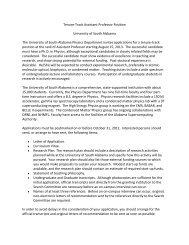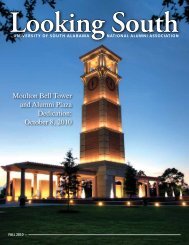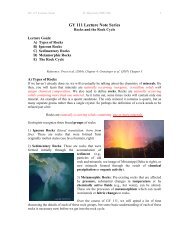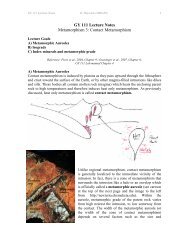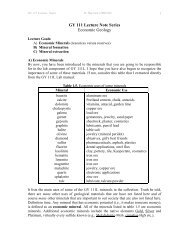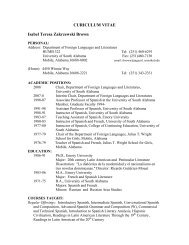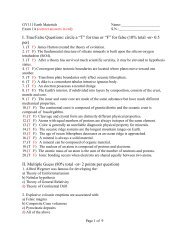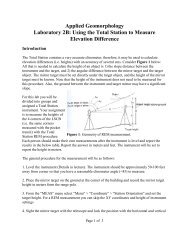Archaeological Survey of the Old Federal Road in Alabama
Archaeological Survey of the Old Federal Road in Alabama
Archaeological Survey of the Old Federal Road in Alabama
You also want an ePaper? Increase the reach of your titles
YUMPU automatically turns print PDFs into web optimized ePapers that Google loves.
morn<strong>in</strong>g salute, <strong>the</strong>n turn<strong>in</strong>g our canoes to Fort Deposit we reached it on <strong>the</strong> morn<strong>in</strong>g <strong>of</strong><strong>the</strong> 26th on our arrival at that place we got <strong>the</strong> wagon refitted up & prepared for <strong>the</strong>journey.” 2Accord<strong>in</strong>g to <strong>of</strong>ficial correspondence, Fort Deposit was built on December 20-22 and <strong>the</strong> army vacated<strong>the</strong> place on December 27. 3 This is essentially <strong>the</strong> extent <strong>of</strong> documentation on Fort Deposit. It existed as amilitary post for just eight days. Yet <strong>the</strong> location rema<strong>in</strong>ed a landmark for years and served as a nucleus<strong>of</strong> American settlement after <strong>the</strong> war, as ceded Creek lands were made available to settlers. We are notaware <strong>of</strong> any physical descriptions <strong>of</strong> <strong>the</strong> fort dat<strong>in</strong>g to <strong>the</strong> war or later. No archaeological test<strong>in</strong>g hasbeen conducted at Fort Deposit. Perhaps after more extensive research <strong>of</strong> <strong>the</strong> exact location <strong>of</strong> <strong>the</strong> fort, <strong>the</strong>site area can be surveyed.Wea<strong>the</strong>rford’s Stand. Wea<strong>the</strong>rford’s Stand appears on both Maxfield Ludlow’s 1816 map andJohn Melish’s 1818 map, and its location probably corresponds to a small circle drawn on AbrahamBradley’s 1812 postal route map. Bradley noted good locations for stage stops or stands, although onlyone is known to have existed <strong>in</strong> <strong>the</strong> vic<strong>in</strong>ity at that time, Manack’s near P<strong>in</strong>tlala. Bradley’s suggestedstand location was situated near a branch <strong>of</strong> Big Swamp Creek – labeled “First” on his map – at a spot 12miles southwest <strong>of</strong> <strong>the</strong> stop at “Laula C.” – referr<strong>in</strong>g to P<strong>in</strong>tlala Creek, presumably mean<strong>in</strong>g Manack’sStore (actually near P<strong>in</strong>chona Creek). The location identified on <strong>the</strong> post-war Ludlow and Melish maps asWea<strong>the</strong>rford’s Stand is approximately 12 miles southwest <strong>of</strong> Manack’s Store. S<strong>in</strong>ce <strong>the</strong>re is no<strong>in</strong>dependent historical evidence for Wea<strong>the</strong>rford’s stand prior to <strong>the</strong> Creek War, while nearby Manack’sStore is extensively documented, we suspect Bradley identified this location and o<strong>the</strong>rs on his 1812 mapas suitable places for stands, but that this one was established after <strong>the</strong> war. The stand was probablyoperated by John Wea<strong>the</strong>rford, a wealthy Creek Indian who cooperated closely with <strong>the</strong> Americansdur<strong>in</strong>g <strong>the</strong> war and was rewarded for his assistance with land grants and o<strong>the</strong>r privileges. That <strong>the</strong> standmight have been run by his bro<strong>the</strong>r William, a prom<strong>in</strong>ent Redstick leader, is unlikely <strong>in</strong> <strong>the</strong> extreme. Wehave found no written descriptions <strong>of</strong> this stand apart from <strong>the</strong>se two map references. Wea<strong>the</strong>rford’s standapparently did not operate very long. Its disappearance from maps after 1818 suggests that JohnWea<strong>the</strong>rford, like <strong>the</strong> Bailey and McGirth families and o<strong>the</strong>r pro-American Creeks with property <strong>in</strong> cededlands, fled to <strong>the</strong> Creek Nation <strong>in</strong> 1819 when anti-Indian violence swept <strong>the</strong> <strong>Alabama</strong> frontier (asdescribed <strong>in</strong> <strong>the</strong> discussion <strong>of</strong> Fort Dale <strong>in</strong> Chapter 6). <strong>Archaeological</strong> survey has not been attemptedbecause <strong>of</strong> <strong>the</strong> vague locational data on this site. Perhaps if more <strong>in</strong>formation becomes available <strong>in</strong> <strong>the</strong>future, <strong>the</strong> stand’s location can be explored.165




